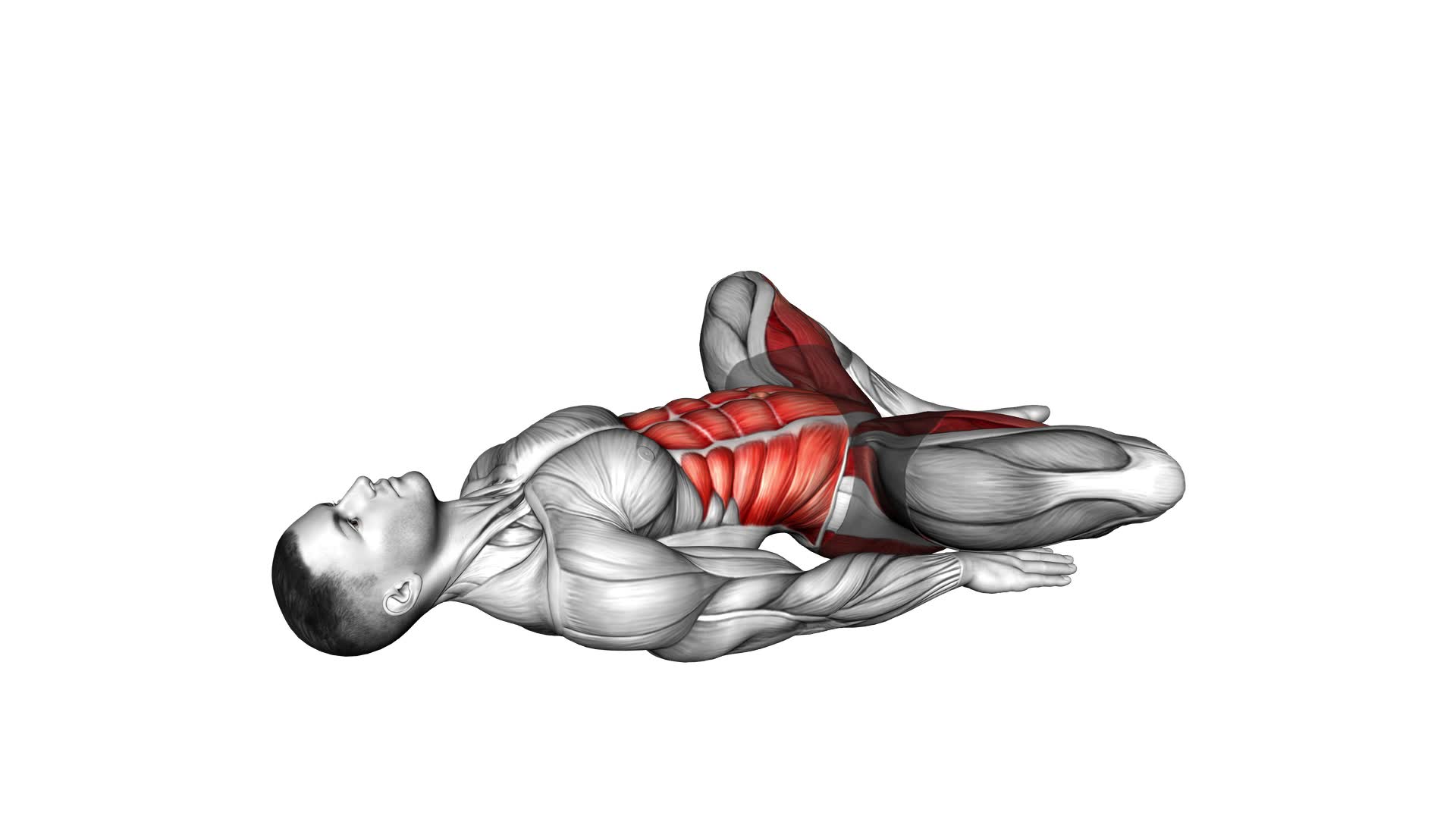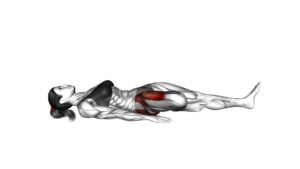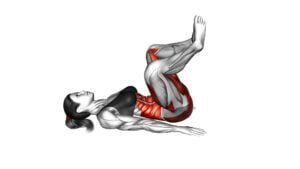Lying Butterfly (Abduction) (male) – Video Exercise Guide & Tips

Looking to tone your lower body? Check out this video exercise guide for the Lying Butterfly Abduction, designed specifically for men.
Watch This Exercise Video
In just a few minutes a day, you can strengthen your glutes, inner thighs, and hip muscles. No need for fancy equipment – all you need is a soft surface to lie on.
Follow these simple instructions and avoid common mistakes to maximize the effectiveness of this exercise.
Get ready to feel the burn!
Key Takeaways
- Lying Butterfly Abduction Exercise targets hip abductor muscles and improves stability, balance, and lower body strength.
- The use of small exercise ball or resistance bands adds resistance and engages muscles, targeting inner thighs, glutes, and hip muscles.
- Proper technique involves engaging inner thighs, glutes, and hip muscles, lying on back with knees bent and feet pressed together, and maintaining slow and controlled movements.
- Variations and modifications include using different resistance levels with resistance bands, ankle weights, or performing the exercise on unstable surfaces for core engagement.
Benefits of Lying Butterfly Abduction Exercise
You can experience several benefits from the lying butterfly abduction exercise. This exercise targets your hip abductor muscles, which are responsible for moving your legs away from the midline of your body. By strengthening these muscles, you can improve your stability, balance, and overall lower body strength. The lying butterfly abduction exercise is also great for activating your gluteus medius, the muscle on the side of your hip that helps with hip stabilization.
Incorporating muscle activation techniques, such as squeezing a small exercise ball between your knees or using resistance bands, can further enhance the effectiveness of this exercise. These techniques increase the resistance and engage your muscles even more.
By regularly performing the lying butterfly abduction exercise, you can prevent injuries, particularly in the hips and knees, by improving the stability of the surrounding muscles. This exercise can also help improve your athletic performance, especially in activities that require lateral movements, such as running, dancing, or playing sports.
Now that you understand the benefits of the lying butterfly abduction exercise, let's move on to the equipment needed for this exercise.
Equipment Needed for Lying Butterfly Abduction Exercise
To perform the lying butterfly abduction exercise, you'll need a small exercise ball or resistance bands. These pieces of equipment are essential for maximizing the benefits of this exercise and ensuring injury prevention.
Using a small exercise ball or resistance bands adds resistance to the movement, challenging your muscles and increasing the effectiveness of the exercise. The lying butterfly abduction exercise primarily targets the inner thighs, glutes, and hip muscles, helping to strengthen and tone these areas. By incorporating these equipment options, you can further enhance muscle engagement and promote greater muscle activation.
The small exercise ball provides stability and support during the exercise, allowing you to maintain proper form and alignment. It also offers versatility, as you can adjust the level of difficulty by using a larger or smaller ball. Resistance bands, on the other hand, provide constant tension throughout the movement, targeting specific muscle groups and improving overall muscle strength.
In addition to the benefits they offer, both the small exercise ball and resistance bands are portable and easy to use at home or in a gym setting. They're cost-effective options that can be incorporated into various exercises to enhance your overall fitness routine.
Proper Technique for Lying Butterfly Abduction Exercise
To properly perform the lying butterfly abduction exercise, focus on engaging your inner thighs, glutes, and hip muscles while maintaining proper form and alignment. This exercise offers several benefits, including strengthening the inner thigh muscles, improving hip stability, and enhancing overall lower body strength. Additionally, it can help prevent injuries by targeting the muscles that support the hips and pelvis.
To begin, lie on your back with your knees bent and the soles of your feet pressed together. Place your hands by your sides for support. Engage your core muscles by drawing your belly button towards your spine. From this starting position, exhale and slowly open your legs out to the sides, maintaining control throughout the movement. Inhale as you return your legs back to the starting position. Keep your feet pressed together and avoid letting your knees drop towards the ground.
By focusing on engaging your inner thighs, glutes, and hip muscles, you ensure that the correct muscles are being targeted during the exercise. This helps to maximize the benefits and minimize the risk of injury.
In the next section, we'll discuss common mistakes to avoid during the lying butterfly abduction exercise to further enhance your technique and results.
Common Mistakes to Avoid During Lying Butterfly Abduction Exercise
To avoid compromising your form and minimizing the risk of injury during the lying butterfly abduction exercise, it's crucial to be aware of common mistakes.
Here are three common mistakes to avoid during this exercise:
- Using momentum instead of engaging the muscles: One common mistake is relying on momentum to lift the legs instead of using the muscles in your hips and thighs. This not only reduces the effectiveness of the exercise but also increases the risk of injury. Focus on engaging your muscles and moving slowly and controlled throughout the entire range of motion.
- Allowing the lower back to lift off the floor: Another mistake to avoid is allowing your lower back to lift off the floor during the exercise. This can put excessive stress on the lower back and increase the risk of strain or injury. Keep your lower back pressed firmly against the floor throughout the movement to maintain proper form and protect your spine.
- Neglecting proper breathing technique: Breathing is often overlooked during exercises, but it plays a crucial role in injury prevention. Take deep breaths in and out throughout the exercise, making sure to exhale as you lift your legs and inhale as you lower them. This helps stabilize your core and maintain proper form.
Variations and Modifications of Lying Butterfly Abduction Exercise
Now let's explore some variations and modifications of the lying butterfly abduction exercise that can help you maximize your workout.
By using different resistance levels, you can challenge your muscles in new ways and continue to make progress.
Additionally, targeting specific muscle groups, such as the inner or outer thighs, can help you achieve a more balanced and sculpted physique.
Lastly, incorporating injury prevention techniques, such as proper form and gradual progression, will ensure that you stay safe and avoid setbacks in your fitness journey.
Different Resistance Levels
Achieve varying levels of resistance in the lying butterfly abduction exercise by utilizing different resistance bands. This allows you to challenge yourself and progress in your workouts. Here are three options to consider:
- Light resistance band: Ideal for beginners or those recovering from an injury. This band offers the least amount of resistance, allowing you to focus on proper form and technique.
- Medium resistance band: Suitable for intermediate exercisers looking for a moderate challenge. It provides more resistance than the light band, helping to strengthen and tone your muscles.
- Heavy resistance band: Designed for advanced individuals who want to push their limits. This band offers the highest level of resistance, demanding greater strength and endurance.
Targeting Specific Muscle Groups
To effectively target specific muscle groups in the lying butterfly abduction exercise, incorporate variations and modifications that provide a greater challenge and engage different muscle fibers. This not only maximizes the effectiveness of the exercise but also helps with injury prevention.
One modification you can try is using ankle weights or resistance bands to add resistance and increase the workload on your hip abductor muscles.
Another variation is performing the exercise on an unstable surface, such as a stability ball or balance board, which activates your core muscles and forces your hip abductors to work harder for stability.
Additionally, changing the tempo of the exercise by slowing down the movement or adding pauses at certain points can further engage the targeted muscles.
Remember to always listen to your body and adjust the difficulty level as needed to avoid any discomfort or pain.
Injury Prevention Techniques
To prevent injuries and enhance the effectiveness of the lying butterfly abduction exercise, incorporate variations and modifications that challenge different muscle fibers.
Here are three injury prevention techniques and workout modifications that you can try:
- Use resistance bands: Attach resistance bands to your ankles during the exercise to provide additional resistance and engage your muscles further.
- Increase the range of motion: Instead of stopping when your knees are parallel to the ground, try lowering your knees closer to the floor to intensify the exercise and target your muscles more effectively.
- Slow down the movement: Instead of performing the exercise quickly, focus on slow and controlled movements to reduce the risk of injury and maximize muscle activation.
By incorporating these injury prevention techniques and workout modifications, you can minimize the chances of getting injured and optimize the benefits of the lying butterfly abduction exercise.
Now, let's move on to some tips for maximizing its effectiveness.
Tips for Maximizing the Effectiveness of Lying Butterfly Abduction Exercise
To maximize the effectiveness of the lying butterfly abduction exercise, it's important to focus on proper form technique. This involves maintaining a stable core, keeping your shoulders and back flat on the ground, and engaging your glutes and inner thigh muscles throughout the movement.
Additionally, to target specific muscles, you can vary the range of motion or add resistance using ankle weights or resistance bands for progression.
Proper Form Technique
Maximize the effectiveness of your lying butterfly abduction exercise by focusing on proper form technique. Here are three key tips to help you prevent injury and maximize muscle activation:
- Maintain proper alignment: Ensure that your head, neck, and spine are in a neutral position throughout the exercise. Avoid excessive arching or rounding of the back.
- Engage your core: Keep your abdominal muscles activated by pulling your belly button towards your spine. This will help stabilize your body and protect your lower back.
- Control your movement: Slow and controlled movements are essential for targeting the correct muscles and avoiding any jerking or swinging motions. Focus on using the targeted muscles to move your legs outward, rather than relying on momentum.
Targeted Muscle Activation
Activate your glutes and adductor muscles effectively during the lying butterfly abduction exercise by implementing these targeted muscle activation techniques. Engaging the correct muscles is crucial for maximizing the effectiveness of this exercise and preventing injuries.
To activate your glutes, focus on squeezing your buttocks together throughout the movement. This will help you maintain stability and generate more power.
For your adductor muscles, imagine pulling your legs together as you bring them back to the starting position. This will engage the inner thigh muscles and enhance the workout.
By incorporating these muscle activation techniques, you can ensure that you're targeting the right muscles and getting the most out of your lying butterfly abduction exercise.
Now, let's move on to the next section and explore variations for progression.
Variations for Progression
Continuing from the previous subtopic, let's now focus on varying the intensity of the lying butterfly abduction exercise to maximize its effectiveness. By incorporating progression variations and targeting specific muscles, you can take your workout to the next level.
Here are three key tips to keep in mind:
- Adjust the resistance: Increase the weight or resistance used during the exercise to challenge your muscles further. This can be achieved by using dumbbells, resistance bands, or weight machines.
- Modify the range of motion: Alter the distance between your legs during the exercise to target different muscle groups. Bringing your legs closer together will emphasize the inner thighs, while spreading them wider will engage the outer thighs.
- Try single-leg variations: Performing the exercise with one leg at a time can intensify the workout and shift the focus onto the glutes and hip muscles.
Remember to listen to your body and progress gradually to avoid injury. With these progression variations, you'll be able to maximize the effectiveness of the lying butterfly abduction exercise.
Frequently Asked Questions
How Many Repetitions of the Lying Butterfly Abduction Exercise Should I Do?
To get the most out of the lying butterfly abduction exercise, it's important to determine the right number of repetitions for you. The lying butterfly abduction exercise offers several benefits, such as strengthening your hip muscles and improving flexibility.
As for the number of repetitions, it can vary depending on your fitness level and goals. It's recommended to start with a comfortable number, like 10 to 12 repetitions, and gradually increase as you get stronger.
Consulting a fitness professional can also help you determine the ideal number of repetitions for your specific needs.
Can the Lying Butterfly Abduction Exercise Help Improve My Flexibility?
The lying butterfly abduction exercise can definitely help improve your flexibility. By incorporating variations of this exercise, such as using resistance bands or increasing the range of motion, you can target different muscle groups and increase your overall flexibility.
The benefits of the lying butterfly abduction exercise include strengthening your hip muscles, improving hip mobility, and enhancing your range of motion. Regularly incorporating this exercise into your workout routine can lead to noticeable improvements in your flexibility over time.
Is the Lying Butterfly Abduction Exercise Suitable for Beginners?
The lying butterfly abduction exercise is suitable for beginners as it helps improve flexibility in the hip and groin area. To progress, you can gradually increase the range of motion or add resistance with ankle weights.
For individuals with lower back pain, modifications can be made by placing a pillow or small cushion under the lower back for support.
Always listen to your body and consult with a professional if you have any concerns.
Can I Perform the Lying Butterfly Abduction Exercise Without Any Equipment?
Yes, you can perform the lying butterfly abduction exercise without any equipment. This exercise targets your inner thigh muscles and can be done lying on your back with your knees bent and feet flat on the ground.
However, if you want to add more challenge and variety to your workout, you can incorporate resistance bands or ankle weights to increase the intensity. Adding resistance can further strengthen your inner thighs and provide additional benefits to your overall fitness routine.
Are There Any Specific Breathing Techniques to Follow During the Lying Butterfly Abduction Exercise?
During the lying butterfly abduction exercise, it's important to maintain proper form. Focus on keeping your back flat on the ground and engaging your core.
As for breathing techniques, you can try inhaling deeply through your nose as you lower your legs, and exhaling through your mouth as you bring them back up.
Incorporating proper breathing can help improve oxygen flow, enhance relaxation, and promote better overall performance during your exercise routine.
Conclusion
In conclusion, the lying butterfly abduction exercise is a beneficial workout for strengthening the hip muscles and improving flexibility.
With proper technique and equipment, this exercise can be done effectively to avoid common mistakes.
Additionally, variations and modifications can be made to suit individual needs.
By following these tips, one can maximize the effectiveness of this exercise and achieve optimal results.

Author
Years ago, the spark of my life’s passion ignited in my mind the moment I stepped into the local gym for the first time. The inaugural bead of perspiration, the initial endeavor, the very first surge of endorphins, and a sense of pride that washed over me post-workout marked the beginning of my deep-seated interest in strength sports, fitness, and sports nutrition. This very curiosity blossomed rapidly into a profound fascination, propelling me to earn a Master’s degree in Physical Education from the Academy of Physical Education in Krakow, followed by a Sports Manager diploma from the Jagiellonian University. My journey of growth led me to gain more specialized qualifications, such as being a certified personal trainer with a focus on sports dietetics, a lifeguard, and an instructor for wellness and corrective gymnastics. Theoretical knowledge paired seamlessly with practical experience, reinforcing my belief that the transformation of individuals under my guidance was also a reflection of my personal growth. This belief holds true even today. Each day, I strive to push the boundaries and explore new realms. These realms gently elevate me to greater heights. The unique combination of passion for my field and the continuous quest for growth fuels my drive to break new ground.







